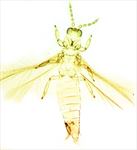
Female

Antenna

Antenna

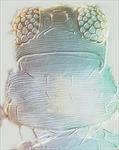
Head & pronotum
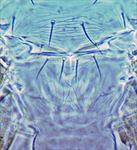
Meso & metanota

Tergites VI–IX
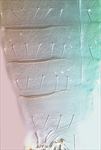
Sternites IV–VII
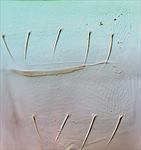
Female sternites VI-VII

Fore wing
Female fully winged. Body yellow, head light brown at anterior; tergites III–VIII and sternites V–VII with dark antecostal ridges; fore wings strongly shaded in basal half, paler toward apex; antennal segment I pale, III–VIII dark. Head with ocellar region and vertex transversely striate; ocellar setae pair III further apart than their length, rising near margins of ocellar triangle; 2 pairs of post-ocular setae longer than ocellar setae III. Pronotum with transverse striae wavy and widely separated; 4 pairs of posteromarginal setae, S2 30 microns long. Metanotum weakly longitudinally reticulate, median setae close to anterior margin. Fore wing first vein with 2–4 setae distally; second vein with 2 setae; posteromarginal fringe cilia wavy except near wing apex. Abdominal tergites II–V median setae close together, longer than distance between bases; lateral thirds of tergites with microtrichial fields bearing 3 discal setae; tergite VIII with no discal microtrichia medially, posteromarginal comb complete; tergite IX with discal microtrichia on posterior half. Sternites with microtrichial fields extending almost to S2.
Male not known.
The country of origin and relationships of S. longipennis remain unclear. It was described from a greenhouse in Bruxelles, and no substantial wild population has yet been found. The genus Scirtothrips currently includes 100 listed species from various parts of the world. Bailey (1964) provided keys to 13 from North America, but that work was based on specimens that were not fully cleared, and thus few structural details were available concerning differences between species. Similarly, Johansen & Mojica-Guzman (1999) provided keys to 37 species from Mexico, but Hoddle et al. (2008) recognised five of these as synonyms of S. perseae, and Mound & Hoddle (2016) placed a further 15 as synonyms of S. citri. Hoddle & Mound (2003) provided information on 21 Scirtothrips species from Australia, and Rugman-Jones et al. (2006) produced a molecular key to several pest species in this genus.
Breeding on leaves, and adults have been collected from many greenhouse decorative plants, including Anthurium, Dieffenbachia, Philodendron [Araceae], Begonia [Begoniaceae] and Cyclamen [Primulaceae] (zur Strassen, 2003). Feeding by this thrips causes some leaf damage to ornamental plants.
The origin of this species is not known, but it has been recorded widely from Southern Europe, Madeira, South Australia, and Lord Howe Island.
THRIPIDAE - THRIPINAE
Scirtothrips longipennis (Bagnall)
Euthrips longipennis Bagnall, 1909: 173
Euthrips parvus Moulton, 1911: 15
Bailey SF (1964) A revision of the genus Scirtothrips Shull (Thysanoptera: Thripidae). Hilgardia 35: 329–362.
Johansen RM, Mojica-Guzman A (1999) The genus Scirtothrips Shull, 1909 (Thysanoptera: Thripidae, Sericothripini), in Mexico. Folia Entomologica Mexicana 104: 23–108.
Hoddle MS, Mound LA, Rugman-Jones PF & Stouthamer R (2008) Synonomy of five Scirtothrips species (Thysanoptera: Thripidae) described from Avocados (Persea americana) in Mexico. Florida Entomologist 91: 16–21.
Mound L & Hoddle M (2016) Scirtothrips species (Thysanoptera, Thripidae) described from mango, Mangifera indica, in Mexico. Florida Entomologist 99 (4):759–764.
Rugman Jones PF, Hoddle MS, Mound LA, & Stouthamer R (2006) Molecular identification key for pest species of Scirtothrips (Thysanoptera: Thripidae). Journal of Economic Entomology 99: 1813–1819.